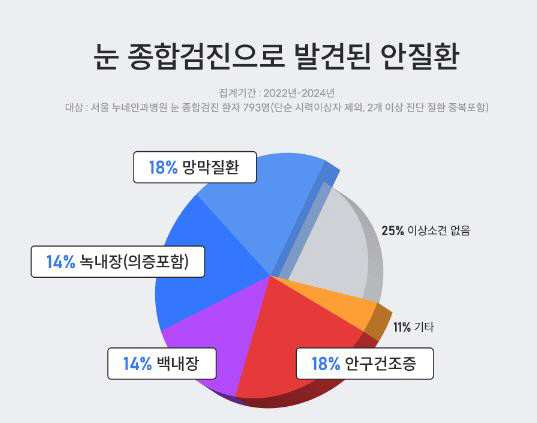EYE HEALTH EYE TO BE LEFTED...Required for intraocular pressure in the 20s and 30s, precise visual field examination for those in their 40s or older, etc
|
According to the '2024 Survey on Eye Health Awareness and Management Status in Asia-Pacific Region', 97.4% of approximately 500 respondents in Korea were concerned about eye health, but only 22.7% actually received regular eye examinations. The perception that it is okay because there is no discomfort was cited as the main reason for delaying the examination.
Currently, national health checkups are conducted every two years and commonly include vision tests, but simple vision tests alone have limitations in early detection of eye structural abnormalities and eye diseases at risk of blindness.
In May, the Ophthalmology Society and the Korean Retinal Society proposed a policy that could introduce 'facial examination' as an essential examination item for national health examinations. When the fundus test is introduced, the retina and optic nerve abnormalities can be checked within five minutes, enabling early diagnosis of various diseases such as eye diseases and hereditary eye diseases caused by complications of underlying diseases as well as the three major blindness diseases that could not be detected by vision tests.
Regular comprehensive eye checkups are now becoming an essential management factor for modern people, as the national level is discussing how to include 'facial examination' as an essential item for health checkups. In particular, due to the recent increase in the use of smartphones and PCs and changes in lifestyle, the age group of elderly eye diseases is gradually decreasing, and more active eye health management is becoming more important than ever. These changes are also affecting the development of eye diseases in all age groups, including children and adolescents.
◇ Eye disease that accelerates the onset due to changes in lifestyle
As the use of electronic devices increases and the age of study begins to decrease, the rate of childhood myopia is also increasing. Myopia can also appear as a genetic factor. If you have more than one parent's myopia, you should pay more attention to your growing ophthalmology and regular check-ups. Childhood myopia is likely to lead to high myopia, and high myopia increases the incidence of retinal detachment and glaucoma. Eye diseases at risk of blindness can also occur in people in their 20s and 30s.
Eye Disease Found by Comprehensive Eye Examination According to a survey conducted at Nune Eye Hospital in Seoul, 18% of 794 people who received comprehensive eye examinations from 2022 to 24 had dry eyes and retinal diseases, and 14% had glaucoma and cataracts, respectively. In 11%, strabismus, military wings, stye, and conjunctivitis were found, and only 25% of patients had no abnormal findings. Some of the patients who received the comprehensive examination found eye diseases that were progressing without subjective symptoms, and were able to receive timely treatment through early detection.
Eye diseases such as macular degeneration, diabetic retinopathy, and glaucoma are eye diseases that have a high risk of blindness, but there are few initial symptoms of awareness, making it difficult to recognize the disease on your own. When symptoms appear, the disease has already progressed considerably and it is highly likely that the timing of treatment has been missed. If you have a family history or an underlying disease such as diabetes and high blood pressure, you are more likely to develop eye diseases due to damage to capillaries or cells in the retina. In particular, as rapid aging progresses from the age of 40, regular comprehensive check-ups are recommended even if there are no symptoms from the age of 40.
◇20s and 30s 'Antensive measurement', 40s and older 'Precision visual field inspection', etc. Required
It is recommended to undergo a fundus examination regardless of age among comprehensive eye examinations. Basic tests, intraocular pressure measurement, corneal topography, and ocular protrusion tests are recommended for those in their 20s and 30s, and for those in their 40s and older, the retina and optic nerve should be checked in more detail through precise field-of-view tests, optic fiber tomography, and ocular optical tomography.
In order to accurately grasp the health condition of the eyes and receive appropriate treatment accordingly, it is recommended to choose an ophthalmologist who is equipped with detailed examination equipment and can comprehensively treat eye diseases such as retina and glaucoma.
Choi Soon-il, director of the Retinal Center at Nune Ophthalmology Hospital, said "The eye is a very important body organ, and once damaged, it is difficult to recover."He stressed that early diagnosis through regular check-ups is very important because blindness risk diseases such as macular degeneration, glaucoma, and diabetic retinopathy may be initially asymptomatic or insignificant. Director Choi said "Since all of these diseases are progressive, it is desirable to have a regular checkup without feeling relieved with a single checkup." he advised.
|
This article was translated by Naver AI translator.





